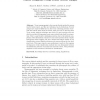Free Online Productivity Tools
i2Speak
i2Symbol
i2OCR
iTex2Img
iWeb2Print
iWeb2Shot
i2Type
iPdf2Split
iPdf2Merge
i2Bopomofo
i2Arabic
i2Style
i2Image
i2PDF
iLatex2Rtf
Sci2ools
AUSAI
2003
Springer
2003
Springer
A Case Study in Feature Invention for Breast Cancer Diagnosis Using X-Ray Scatter Images
Abstract. X-ray mammography is the current clinical method for screening for breast cancer, and like any technique, has its limitations. Several groups have reported di’¼Ćerences in the X-ray scattering patterns of normal and tumour tissue from the breast. This gives rise to the hope that X-ray scatter analysis techniques may lead to a more accurate and cost e’¼Ćective method of diagnosing beast cancer which lends itself to automation. This is a particularly challenging exercise due to the inherent complexity of the information content in X-ray scatter patterns from complex hetrogenous tissue samples. We use a simple na┬©─▒ve Bayes classier as our classi’¼ücation system. High-level features are extracted from the low-level pixel data. This paper reports some preliminary results in the ongoing development of this classi’¼ücation method that can distinguish between the di’¼Ćraction patterns of normal and cancerous tissue, with particular emphasis on the invention of features for classi’¼...
| Added | 06 Jul 2010 |
| Updated | 06 Jul 2010 |
| Type | Conference |
| Year | 2003 |
| Where | AUSAI |
| Authors | Shane M. Butler, Geoffrey I. Webb, Rob A. Lewis |
Comments (0)

